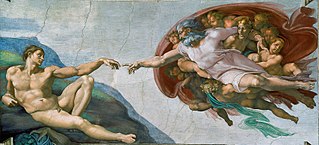
Fresco is a technique of mural painting executed upon freshly laid ("wet") lime plaster. Water is used as the vehicle for the dry-powder pigment to merge with the plaster, and with the setting of the plaster, the painting becomes an integral part of the wall. The word fresco is derived from the Italian adjective fresco meaning "fresh", and may thus be contrasted with fresco-secco or secco mural painting techniques, which are applied to dried plaster, to supplement painting in fresco. The fresco technique has been employed since antiquity and is closely associated with Italian Renaissance painting. The word fresco is commonly and inaccurately used in English to refer to any wall painting regardless of the plaster technology or binding medium. This, in part, contributes to a misconception that the most geographically and temporally common wall painting technology was the painting into wet lime plaster. Even in apparently Buon fresco technology, the use of supplementary organic materials was widespread, if underrecognized.

Giovanni Francesco Barbieri, better known as Guercino, or il Guercino[ɡwerˈtʃiːno], was an Italian Baroque painter and draftsman from Cento in the Emilia region, who was active in Rome and Bologna. The vigorous naturalism of his early manner contrasts with the classical equilibrium of his later works. His many drawings are noted for their luminosity and lively style.

Simon Vouet was a French painter who studied and rose to prominence in Italy before being summoned by Louis XIII to serve as Premier peintre du Roi in France. He and his studio of artists created religious and mythological paintings, portraits, frescoes, tapestries, and massive decorative schemes for the king and for wealthy patrons, including Richelieu. During this time, "Vouet was indisputably the leading artist in Paris," and was immensely influential in introducing the Italian Baroque style of painting to France. He was also "without doubt one of the outstanding seventeenth-century draughtsmen, equal to Annibale Carracci and Lanfranco."

Gino Severini was an Italian painter and a leading member of the Futurist movement. For much of his life he divided his time between Paris and Rome. He was associated with neo-classicism and the "return to order" in the decade after the First World War. During his career he worked in a variety of media, including mosaic and fresco. He showed his work at major exhibitions, including the Rome Quadrennial, and won art prizes from major institutions.

Paul-Jacques-Aimé Baudry was a French painter.
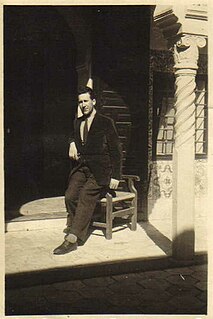
Maurice Boitel was a French painter.

Eugène Burnand was a prolific Swiss painter and illustrator from Moudon, Switzerland. Born of prosperous parents who taught him to appreciate art and the countryside, he first trained as an architect but quickly realised his vocation was painting. He studied art in Geneva and Paris then settled in Versailles. In the course of his life he travelled widely and lived at various times in Florence, Montpellier, Seppey (Moudon) and Neuchâtel. His later years were spent in Paris where he died a celebrated and well respected artist both in Switzerland and France. He was primarily a realist painter of nature. Most of his works were of rural scenes, often with animals, the depiction of which he was a master. He increasingly painted human figures and by the end of his career could be called a portraitist whose skill revealing character was profound.
Raphaël Thierry (1972-2021) is a French visual artist, painter and illustrator. He displays his work on various media such as drawings, paintings, sculptures, performances, installations and develops his artistic practice under multiple identities. Raphael Thierry lives between Paris and Avignon, France.
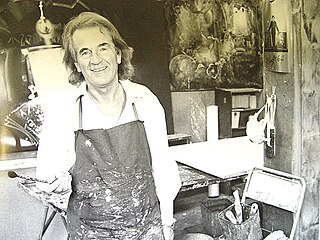
Augustin François Guille, called Archiguille was a French painter.
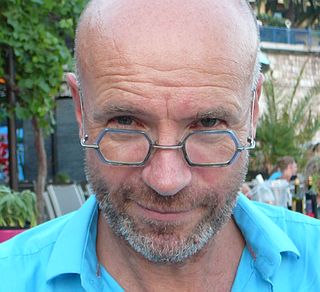
Patrick Moya, is a Southern French artist, living in Nice on the French Riviera. He is a part of the artistic movement "Ecole de Nice". Moya has been at the forefront since the 1970s of straddling the latest forms of media and technology to benefit art rather than rendering it extinct. He is an early pioneer of video art.
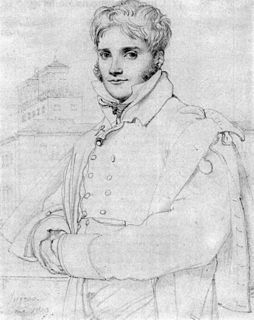
Merry-Joseph Blondel was a French history painter of the Neoclassical school. He was a winner of the prestigious Prix de Rome in 1803. After the salon of 1824, he was bestowed with the rank of Knight in the order of the Legion d'Honneur by Charles X of France and offered a professorship at the École nationale supérieure des Beaux-Arts: a position in which he remained until his death in 1853. In 1832, he was elected to a seat at the Académie des Beaux-Arts in Paris.

Mildred Bendall was an active force of the avant-garde in Bordeaux, and instrumental in building a real exchange with Paris.

Joseph Jean Ferdinand Kutter (1894–1941) is considered one of Luxembourg's most important painters. He was greatly influenced by the Impressionists but developed his own distinctive Expressionist style.

Dominique Lang (1874–1919) is considered to be Luxembourg's most important Impressionist painter. He painted both portraits and landscapes although he was employed as a high-school teacher.

Néjib Belkhodja was a Tunisian painter. He was the brother-in-law of economist Ali Zouaoui; among his works were the designs for several Tunisian stamps.

La Vie is a 1903 oil painting by Pablo Picasso. It is widely regarded as the pinnacle of Picasso's Blue Period.
Aimé Venel is a French painter and drawer who focuses on figurative and symbolist style. He creates his own style of figurative arts elegance that primarily lies between symbolist painting and expressionism art, closely related to romanticism. He is a self-taught man whose artwork is influenced by women's beauty. Aimé Venel was a Scientologist for years, before withdrawing from the movement.

The Syrian Cultural Caravan is an artistic and cultural movement led by Syrian artists. Started in 2014 as a project called "Freedom for the Syrian People", it took the form of a road trip, taking off from France and continuing across Europe. In face of the success met in 2014, the project became a movement entitled the "Syrian Cultural Caravan". The project aims at bringing a wide diversity of artists together around a multi-format exhibition mixing paintings, photographs, dance, music, film screenings, as well as debates and the sharing of food. The goal of the project is "to promote Syrian civil society and contemporary Syrian art and culture" by debunking the public's expectations. Artists create a platform for debate on which they can offer their own narrative to counterweight the mainstream narrative of the media.

Andries Cornelis Lens or André Corneille Lens was a Flemish painter, illustrator, art theoretician and art educator. He is known for his history paintings of biblical and mythological subjects and portraits. Wishing to contribute to the revival of painting in Flanders, he took his inspiration from the classical traditions of the 16th century and drew inspiration from Raphael. He was thus a promoter of Neoclassicism in Flemish art. He was a teacher and director of the Academy of Fine Arts of Antwerp. Lens was court painter to the governor-general of the Austrian Netherlands and settled in Brussels where he married. Lens was also a writer and historian who published an illustrated book which discussed the costumes, ornaments and furnishings of the various people in Antiquity and another book setting out his art theories.
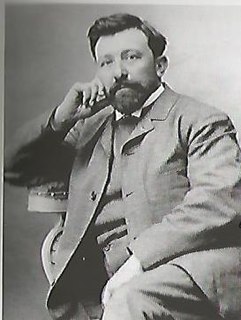
Eugène Henri Alexandre Chigot was a post impressionist French painter. A pupil of his father, the military painter Alphonse Chigot, in 1881 he entered the internationally renowned École des Beaux-Arts in Paris where he was exposed to the ideas of the realist movement of the Barbizon School and to Impressionism. He settled in Étaples in the Pas-de-Calais in an artists’ colony, later returning to Paris where he became a founder of the Salon d’Automne. An official military painter he painted a series of canvases in Calais and Nieuport recording the destruction caused by the First World War.